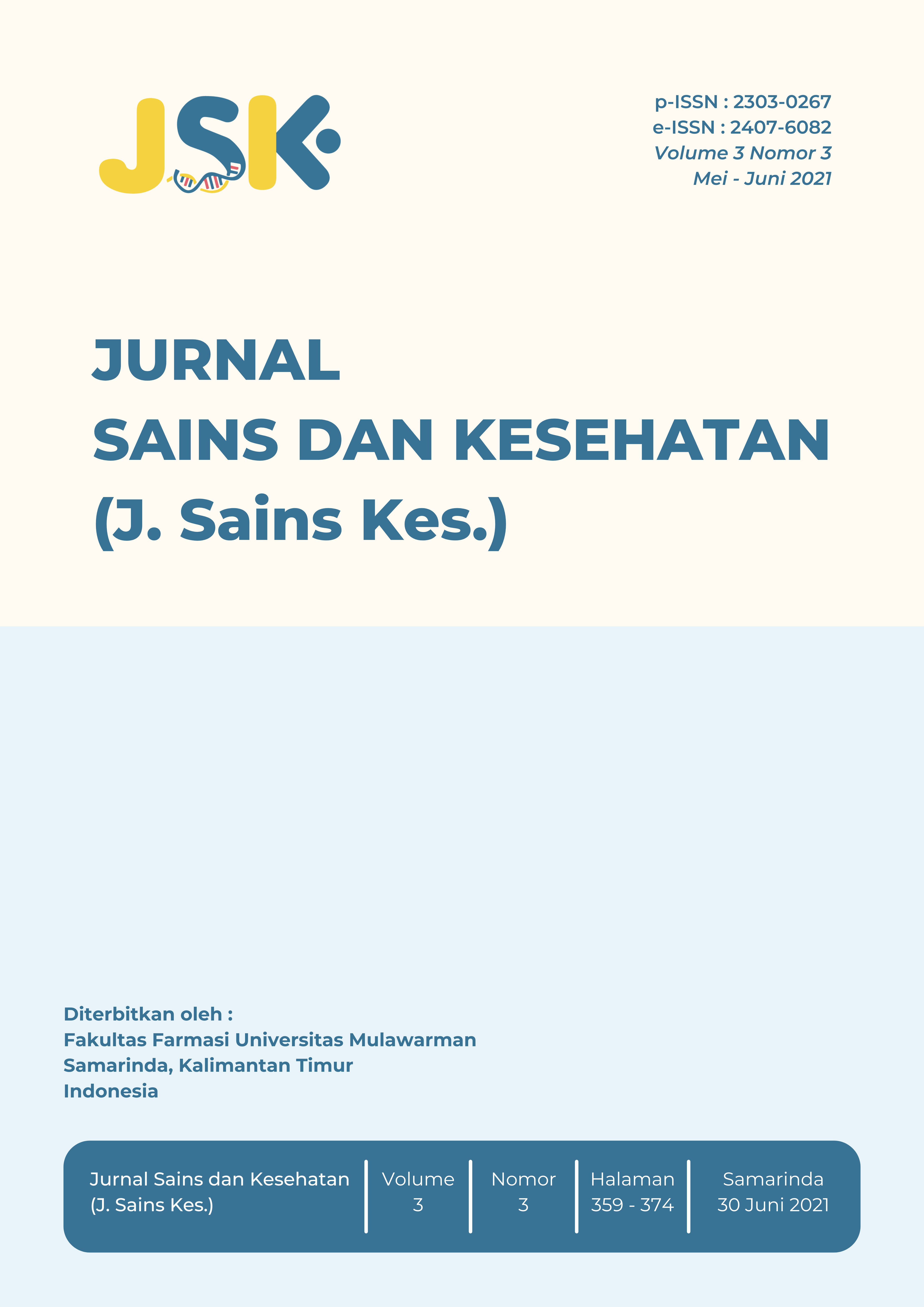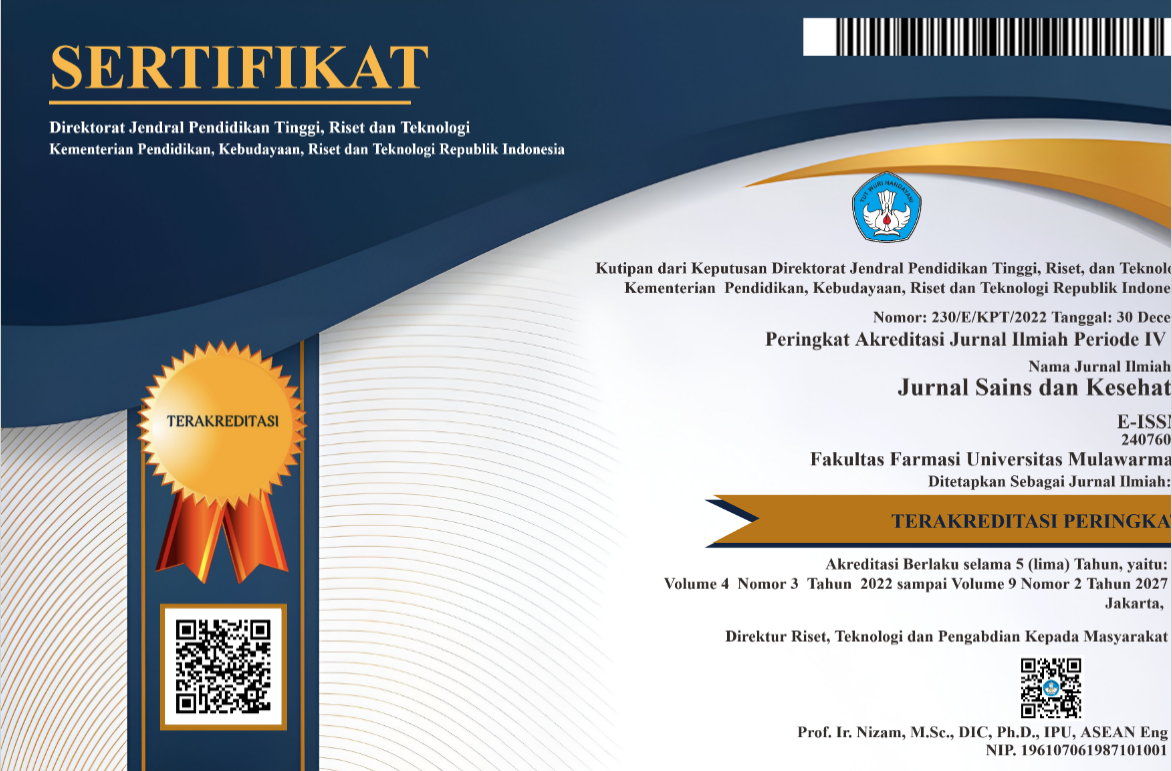Karakterisasi Fungi Endofit Syzygium polyanthum (Wight) Walp. Berdasarkan Gen ITS Sebagai Penghasil Senyawa Antibakteri
Endophytic Fungi Characterization Syzygium polyanthum (Wight) Walp. Based on ITS Genes as Producers of Antibacterial Compounds
Keywords:
Syzygium polyanthum, fungi endofit, antimikroba, analisis filogenetik, Penicillium sp. ColletotrichiumAbstract
References
Baylis, C.L., Penn, C.W., Thielman, N.M., Guerrant, R.L., Jenkins, C., Gillespie, S.H., 2006. Eschericia coli and Shigella spp., dalam Gillespie, Hawkey, P.M. (Eds.), Principles and Practice of Clinical Bacteriology, 347-365
Burhamzah, R., G. Alam, and H. Rante. "Characterization of Antibacterial-Producing Endophytic Fungi of Syzygium polyanthum Leaves." Infectious disorders drug targets (2018).
Bolouiri, M., Sadiki, M., dan Ibnsouda, S.K. 2016. Method for in vitro evaluating antimicrobial activity : A Review. Journal of Pharmaceutical Analysis 6 (2016) : 71-79
Devi P, Rodriguez C, Naik CG, D’ Souza L. 2012. Isolation and Characterization of Antibacterial compound from a Mangrove-Endophytic Fungus, Penicilium chrysogenum MTCC 5108. Indian J. Microbiol 2012 Dec; 52 (4): 617-623
Ediningsari, Anisa R. 2008. Identifikasi khamir dari perairan mangrove dan laut cagar alam pulau rambut berdasarkan daerah Internal Transcribed Spacer (ITS).
Frohlich, J., Hyde, K. D., Petrini, O. 2000. Dalam: Guo, L.D., K.D. Hyde and E.C.Y, Liew. 2000. Identification of endophytic fungi from Livistona Chinensis based on morphology and rDNA sequences, Research New Phytol. 147 :617-630
Guo, L.D., K.D. Hyde and E.C.Y, Liew. 2000. Identification of endophytic fungi from Livistona chinensis based on morphology and rDNA sequnces. Research new phytol. 147:617-630
Hillis, D.M., B.K. Marble and C. Moritz. 1996. Applications of molecular systematics: The state of the field and a look to the future. Molecular systematics.2nd Ed. Sinauer Associates Inc. Sunderland.
Jain M, Nijhawan A, Tyagi AK, Khurana JP (2006) Validation of housekeeping genes as internal control for studying gene expression in rice by quantitative real-time PCR. Biochemical and Biophysical Research Communications 345: 646–651.
Kuncoro, H., & Sugijanto, N. E. (2011). Jamur Endofit, Biodiversitas, Potensi Dan Prospek Penggunaannya Sebagai Sumber Bahan Obat Baru. Journal of Tropical Pharmacy and Chemistry, 1(3), 247-262.
Lau, K.Y., Zainin, N.S., Abas, F., dan Rukayadi. Y. 2014. Antibacterial and Sporicidal Activity of Eugenia polyantha Wight. Against Bacilus cereus and Bacilus subtilis. International Journal of Current Microbiology and Applied Science Vol 3 Number 12 (2014) pp. 499-510.
Menpara, D. Dan Chanda, S. 2013. Endophytic bacteria –unexplored reservoir of antimcrobials for combating microbial pathogens Microbial pahtogens and strategies for comabating them: science, tecnology and education (A. Mendez Villaz Ed.)
Meyer A., Todt C., Mikkelsen N.T., and Lieb B., 2010, Fast evolving 18S rRNA sequences from Solenogastres (Mollusca) resist standard PCR amplification and give new insights into mollusk substitution rate heterogeneity, BMC Evolutionary Biology 10 : 10-70.
Nei, M. and S. Kumar. 2000. Molecular evolution and phylogenetics. Oxford University Press Inc. New York.
Nicot N, Hausman JF, Hoffmann L, Evers D (2005) Housekeeping gene selection for real-time RT-PCR normalization in potato during biotic and abiotic stress. J Exp Bot 56(421): 2907–2914.
Patel, J. B. 2001. 16S rRNA gene sequencing for bacterial pathogen identification in the clinical laboratory. Mol Diagn. 6:313-321.
Prasetyoputri, A.; & Atmosukarto, I. 2006, Mikroba Endofit: Sumber Molekul Acuan Baru yang Berpotensi. BioTrends. Vol I. No.2. 2006: 13-15 2013. Identification and Bioactive Potential of Endophytic Fungi Isolated from Selected Plants of the Western Himalayas. Springer plus 2013 2:8
Radji, M. (2012). Peranan bioteknologi dan mikroba endofit dalam pengembangan obat herbal. Pharmaceutical Sciences and Research (PSR), 2(3), 113-126.
Rizki MI dan Hariandja EM. 2015. Review: Aktivitas Farmakologis, Senyawa Aktif, dan Mekanisme Kerja Daun Salam (Syzygium polyanthum) . Prosiding seminar nasional & workshop “Perkembangan Terkini Sains Farmasi dan Klinik 5” Padang 6-7 November 2015.
Schulz, B.; & Boyle, C. 2006, What Are Endophytes? dalam: Schulz, B.; Boyle, C.; & Sieber, T.N. (Eds.). Soil Biology. Volume 9. Microbial Root Endophytes. Springer-Verlag. Berlin Heidelberg. 2006: 1-13.
Singh, D., Rathod, V., Ninganagouda, S., Herimath, J., & Kulkarni, P. (2013). Biosynthesis of silver nanoparticle by endophytic fungi Pencillium sp. isolated from Curcuma longa (turmeric) and its antibacterial activity against pathogenic gram negative bacteria. Journal of pharmacy research, 7(5), 448-453.
Strobel, G.A.; Daisy, B.; Castillo, U.; & Harper, J. 2004, Natural Product from Endophytic Microorganism. J. Nat. Prod. 2004. 67: 257-268
Tamura K, Strecher G, Peterson D, Filipski A and Kumar S. 2013. MEGA6: Molecular Evolutionary Genetics Analysis version 6.0. Mol Biol Evol 2013; 30: 2725-2729.
Tan, R.X.; & Zou, W.X. 2001, Endophytes: a rich source of functional metabolites. Nat. Prod. Rep.18 : 448-459
Tejesvi, M.V.; Nalini, M.S.; Mahesh, B.; Prakash, H.S.; Kini, K.R.; Shetty, H.S.; & Ven, S. 2007, New Hopes From Endhopythic Fungal Secondary metabolite. Bol. Soc. Quím. Méx., 1(1): 19-26
Travers, A., & Muskhelishvili, G. (2015). DNA structure and function. The FEBS journal, 282(12), 2279-2295.
Downloads
Published
Issue
Section
Deprecated: json_decode(): Passing null to parameter #1 ($json) of type string is deprecated in /home/jskff/public_html/plugins/generic/citations/CitationsPlugin.php on line 68
How to Cite
Most read articles by the same author(s)
- Asti Vebriyanti Asjur, Elvira Santi, Tamzil Azizi Musdar, Syaifullah Saputro, Rosmiati Anggraini Rahman, Formulasi dan Uji Aktivitas Antioksidan Sediaan Face Mist Ekstrak Etanol Kulit Apel Hijau (Pyrus malus L.) dengan Metode DPPH , Jurnal Sains dan Kesehatan: Vol. 5 No. 3 (2023): J. Sains Kes.
- Asti Vebriyanti Asjur, Syaifullah Saputro, Tamzil Azizi Musdar, Mifta Khaerati Ikhsan, Formulasi dan Uji Efektivitas Shampo Antiketombe Minyak Atsiri Seledri (Apium graveolens) terhadap Jamur Candida albicans , Jurnal Sains dan Kesehatan: Vol. 4 No. 5 (2022): J. Sains Kes.
Similar Articles
- Jessie Elviasari, Rolan Rusli, Adam M. Ramadhan, Identifikasi Metabolit Sekunder Dan Uji Aktivitas Antibakteri Isolat Jamur Endofit Daun Beluntas (Pluchea indica (L.) Less.) , Jurnal Sains dan Kesehatan: Vol. 1 No. 5 (2016): J. Sains Kes.
- Umi Khusnul Khotimah, M. Arifuddin, Fika Aryati, Islamudin Ahmad, Isolasi Fungi Endofit Batang Bajakah (Uncaria nervosa Elmer) dan Pengujian Toksisitas dengan Metode BSLT , Jurnal Sains dan Kesehatan: Vol. 5 No. SE-1 (2023): Spesial Edition J. Sains Kes.
- Khoirunnisa Khoirunnisa, Novianty Indjar Gama, M. Arifuddin, Rolan Rusli, Bioaktivitas Ekstrak Etil Asetat Hasil Fermentasi Fungi Endofit Batang Bajakah (Uncaria nervosa Elmer.) , Jurnal Sains dan Kesehatan: Vol. 5 No. SE-1 (2023): Spesial Edition J. Sains Kes.
- Yadi Yasir, Yuniati Yuniati, Swandari Paramita, Mona Zubaidah, Abdul Mu’ti, Danial Danial, Analisis Bioautografi Dengan Kromatografi Lapis Tipis Pada Ekstrak Etanol Daun Caesalpinia sumatrana ROXB. Terhadap Bakteri Penyebab Infeksi Nosokomial , Jurnal Sains dan Kesehatan: Vol. 1 No. 7 (2017): J. Sains Kes.
- Fuji Fadhilla Sandy, Yasmiwar Susilawati, Zelika Mega Ramadhania, Review: Analisis Kualitatif dan Kuantitatif Kandungan Senyawa Kimia Herba Sasaladaan (Peperomia pellucida (L) H.B.K) , Jurnal Sains dan Kesehatan: Vol. 2 No. 4 (2020): J. Sains Kes.
- Arfiani Arifin, Tahirah Tahirah, Riska Ninsi, Uji Efektivitas Formulasi Gel Ekstrak Etanol Daun Tembelekan (Lantana Camara L.) Asal Wangi-Wangi Sulawesi Tenggara Terhadap Luka Bakar pada Kelinci (Oryctolagus Cuniculus) , Jurnal Sains dan Kesehatan: Vol. 5 No. 6 (2023): J. Sains Kes.
- Jessie Elviasari, Rolan Rusli, Adam M. Ramadhan, Isolasi Jamur Endofit Daun Beluntas (Pluchea indica (L.) Less) , Jurnal Sains dan Kesehatan: Vol. 1 No. 3 (2015): J. Sains Kes.
- Vilca Veronica Hasiani, Islamudin Ahmad, Laode Rijai, Isolasi Jamur Endofit dan Produksi Metabolit Sekunder Antioksidan dari Daun Pacar (Lawsonia inermis L.) , Jurnal Sains dan Kesehatan: Vol. 1 No. 4 (2015): J. Sains Kes.
- Desi Purwaningsih, Destik Wulandari, Uji Aktivitas Antibakteri Hasil Fermentasi Bakteri Endofit Umbi Talas (Colocasia esculenta L) terhadap Bakteri Pseudomonas aeruginosa , Jurnal Sains dan Kesehatan: Vol. 3 No. 5 (2021): J. Sains Kes.
- Sri Gustini Husein, Melvia Sundalian, Nurul Husna, Review: Analisis Komponen Senyawa Kimia Krokot (Portulaca oleraceae L. dan Portulaca grandiflora Hook.) , Jurnal Sains dan Kesehatan: Vol. 3 No. 2 (2021): J. Sains Kes.
You may also start an advanced similarity search for this article.




